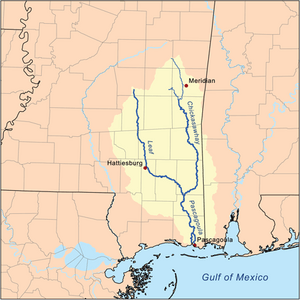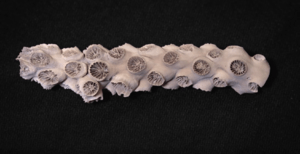Chickasawhay River facts for kids
Quick facts for kids Chickasawhay River |
|
|---|---|

Map of the Pascagoula River and watershed
|
|
| Physical characteristics | |
| Main source | Confluence of Okatibbee Creek and Chunky River in Clarke County, Mississippi 244 ft (74 m) 32°10′58″N 88°49′19″W / 32.1827778°N 88.8219444°W |
| River mouth | Confluence with the Leaf River forming the Pascagoula River 43 ft (13 m) 30°58′57″N 88°43′49″W / 30.9825°N 88.7302778°W |
| Length | 210 mi (340 km) |
| Basin features | |
| Progression | Chickasawhay River → Pascagoula River → Gulf of Mexico |
| GNIS ID | 692890 |
The Chickasawhay River is a long river in southeastern Mississippi, United States. It stretches for about 210 miles (338 km). This river is a main branch, or tributary, of the Pascagoula River. The Pascagoula River eventually flows into the Gulf of Mexico. Some smaller streams that feed the Chickasawhay also collect water from western Alabama. The name "Chickasawhay" comes from the Choctaw people. It means "Chickasaw potato".
River Facts: Where Does the Chickasawhay River Start and End?
The Chickasawhay River begins in Clarke County, Mississippi. It forms where two smaller waterways meet. These are the Chunky River and Okatibbee Creek. The town of Enterprise grew up near this meeting point.
The river then flows south through several counties. These include Clarke, Wayne, and Greene counties. It continues into northern George County. Finally, it joins with the Leaf River. Together, they form the larger Pascagoula River.
Towns Along the Chickasawhay River
As the Chickasawhay River travels, it passes by several towns. These towns include Stonewall, Quitman, and Shubuta. It also flows past Waynesboro and Leakesville. Many of these towns, like Shubuta, started as trading posts. Early European American settlers built them near villages of the native Choctaw people.
Ancient Life: Fossils of the Chickasawhay River
The Chickasawhay River area is famous for its many fossils. These fossils were left behind over 35 million years. They tell us about ancient life forms.
Dr. Mark Puckett, a geology expert, has studied this area for many years. He works at the University of Southern Mississippi. Dr. Puckett says that many fossils found here were unique. They were the first of their kind ever studied on Earth.
Some fossils found along this river are from sea creatures. This shows that long ago, this area was covered by the sea. Some of these sea life fossils are now found all over the world. But they were first discovered right here. Some ancient species are even named after local towns and landmarks.


